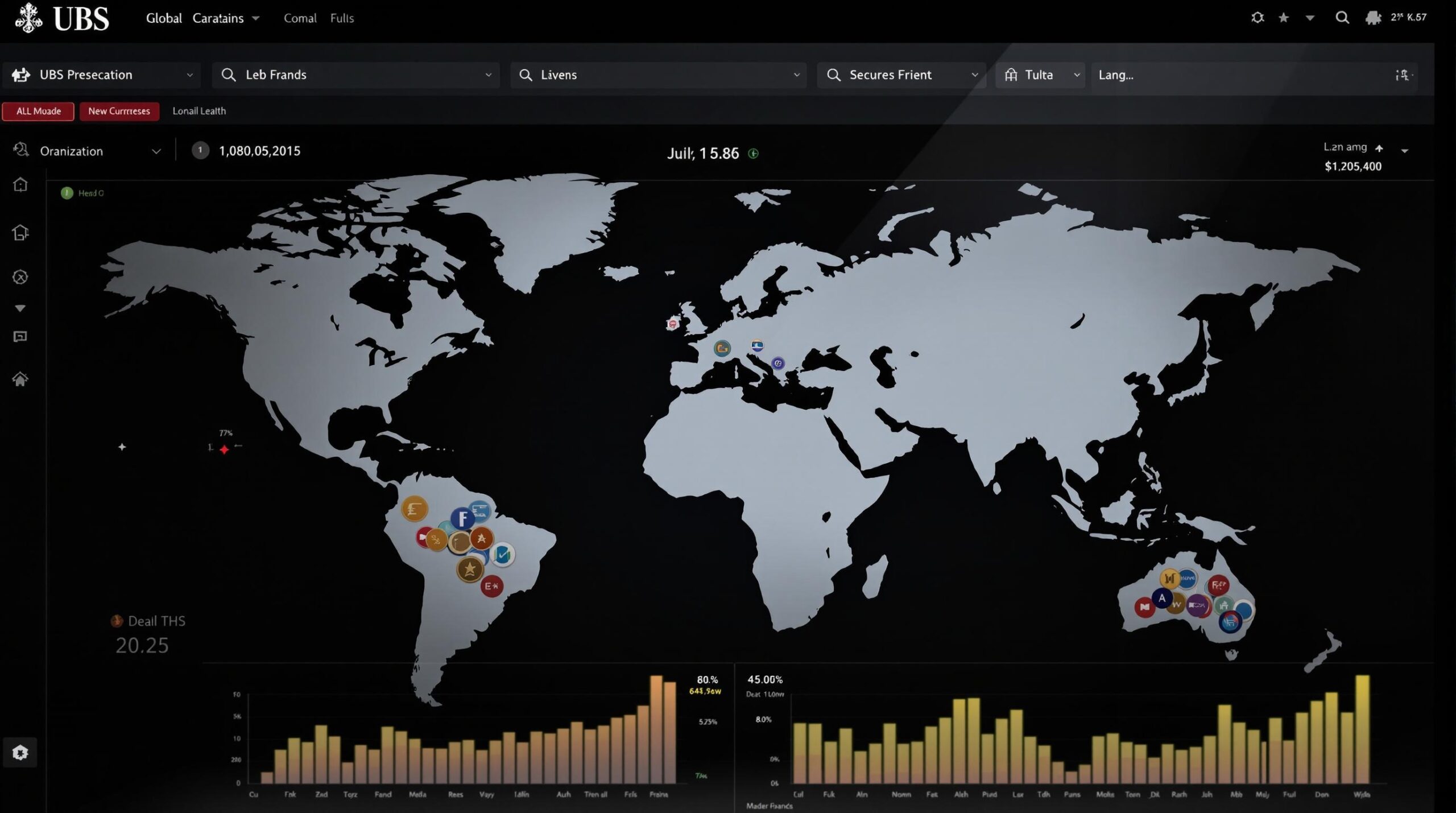BitcoinWorld

Currency Allocation Strategy: Mastering Smart Investment Diversification with the UBS Guide
In the fast-paced world of digital assets, where volatility is a constant companion, the concept of diversification is more critical than ever. But beyond diversifying across different cryptocurrencies or into traditional stocks and bonds, have you ever considered the profound impact of your currency allocation strategy? Just as savvy crypto investors seek stability amidst market swings, traditional finance giants like UBS recognize the immense power of strategically managing exposure to various global currencies. It’s not just about what you invest in, but also which currency your investments are denominated in, and how that can protect or enhance your wealth.
UBS, a global leader in wealth management, has long advocated for a meticulous approach to managing financial assets. Their latest guidance on currency allocation serves as a vital resource for investors aiming to optimize their portfolios in an increasingly interconnected world. This comprehensive UBS guide demystifies the often-complex realm of foreign exchange, offering a clear, step-by-step framework to help individuals and institutions alike make informed decisions about where their money should reside globally. Understanding and implementing an effective Forex portfolio strategy can significantly mitigate risks, capitalize on economic shifts, and ultimately contribute to long-term wealth preservation and growth. Let’s dive into how you can adopt these sophisticated strategies to your own financial journey.
Understanding Your Currency Allocation Strategy – Why It Matters More Than Ever?
At its core, a currency allocation strategy involves deciding which currencies to hold your assets in, or in which currencies your liabilities are denominated. For many, this might seem like a concern only for large multinational corporations or high-net-worth individuals. However, in today’s globalized economy, even everyday investors are indirectly exposed to currency fluctuations. If you own international stocks, bonds, or even some ETFs, their performance in your local currency can be heavily influenced by exchange rate movements. For those deeply involved in the cryptocurrency space, understanding global currency dynamics can offer a valuable perspective on macro trends that often spill over into digital asset markets. A well-thought-out strategy can provide several compelling benefits:
- Risk Mitigation: Diversifying across currencies can hedge against the depreciation of your home currency, protecting your purchasing power. If one currency weakens, another might strengthen, balancing your overall portfolio value.
- Return Enhancement: Strategic currency bets, though riskier, can offer opportunities for additional returns if you correctly anticipate currency appreciation. This is distinct from speculative trading; it’s about a long-term view.
- Geographic Diversification: It naturally aligns with diversifying investments across different regions and economies, spreading risk beyond a single country’s economic fortunes.
- Inflation Protection: Holding currencies from countries with lower inflation rates or stronger economic fundamentals can act as a safeguard against inflation in your domestic economy.
Ignoring currency exposure is akin to ignoring a significant component of your investment risk and return profile. It’s a crucial layer of financial planning that can provide resilience in turbulent times.
The UBS Guide to Crafting Your Forex Portfolio for Resilience
UBS emphasizes a disciplined, methodical approach to building and managing a robust Forex portfolio. Their guidance isn’t about chasing quick gains but rather about strategic positioning for long-term stability and growth. Here’s a breakdown of the key steps advocated by the global financial giant:
- Assess Your Financial Goals and Risk Tolerance: Before making any currency decisions, understand what you want to achieve. Are you saving for retirement, a down payment on an international property, or simply looking to preserve capital? Your time horizon and comfort with risk will dictate the aggressiveness of your currency allocation. A conservative investor might stick to major, stable currencies, while a more aggressive one might explore emerging market currencies for higher potential returns, albeit with greater volatility.
- Understand Macroeconomic Factors: Currencies are profoundly influenced by macroeconomic fundamentals. UBS encourages investors to look at interest rate differentials, inflation rates, economic growth forecasts, current account balances, and fiscal policies of different nations. A country with rising interest rates and strong economic growth, for instance, might see its currency appreciate.
- Identify Core and Satellite Currencies: The UBS guide often suggests a core-satellite approach. Your ‘core’ allocation might be in stable, highly liquid currencies like the USD, EUR, JPY, GBP, or CHF, which provide a foundation. Your ‘satellite’ allocation could involve smaller, strategic positions in currencies that offer specific opportunities or hedges, perhaps from fast-growing emerging markets or commodity-rich nations.
- Consider Geopolitical and Policy Risks: Political stability, trade policies, and central bank interventions can dramatically impact currency values. A sudden shift in government policy or an unexpected geopolitical event can lead to rapid currency depreciation or appreciation. Staying informed about these global developments is crucial.
- Implement and Monitor: Once you’ve determined your desired allocation, implement it through various financial instruments such as currency ETFs, mutual funds, or even directly holding foreign currency accounts. Crucially, currency allocation is not a ‘set it and forget it’ strategy. Regular monitoring is essential. Economic conditions, interest rates, and geopolitical landscapes are constantly evolving, necessitating periodic reviews and potential rebalancing of your Forex portfolio.
Here’s a simplified illustration of how different economic scenarios might influence currency considerations:
| Economic Scenario | Potential Currency Impact | UBS-aligned Strategy Suggestion |
|---|---|---|
| Rising Interest Rates (e.g., US) | USD likely to strengthen due to higher returns on dollar-denominated assets. | Increased allocation to USD or dollar-pegged assets. |
| High Inflation (e.g., Eurozone) | EUR might weaken as purchasing power erodes. | Reduced EUR exposure, consider inflation-hedging currencies (e.g., CHF, JPY). |
| Strong Commodity Prices (e.g., Australia) | AUD (commodity currency) likely to strengthen. | Consider tactical allocation to AUD or CAD for commodity exposure. |
| Geopolitical Instability (e.g., Europe) | Safe-haven currencies (JPY, CHF, USD) may strengthen. | Shift towards safe-haven currencies to preserve capital. |
Analyzing Global Market Trends for Optimal Investment Diversification
A key pillar of any successful investment diversification strategy, particularly when it comes to currencies, is a keen understanding of global market trends. Currencies do not operate in isolation; they are deeply intertwined with economic performance, central bank policies, and international trade flows. To make informed decisions about your currency exposure, it’s essential to monitor several critical indicators:
- Interest Rate Differentials: This is arguably the most significant driver of short-term currency movements. Investors tend to move capital to countries offering higher interest rates, which increases demand for that country’s currency. Pay close attention to central bank announcements from the Federal Reserve, European Central Bank, Bank of Japan, etc.
- Inflation Rates: High inflation erodes purchasing power and can lead to a weakening currency if not accompanied by corresponding interest rate hikes. Conversely, stable or low inflation, coupled with economic growth, can make a currency more attractive.
- Economic Growth and Outlook: Strong GDP growth, low unemployment, and robust manufacturing data generally support a currency. Investors are attracted to economies that are expanding, as this suggests potential for higher returns.
- Current Account Balances: This measures a country’s trade balance (exports minus imports) and net income from abroad. A persistent current account deficit can indicate that a country is importing more than it’s exporting, potentially leading to currency depreciation.
- Geopolitical Developments: Wars, political instability, trade disputes, and international sanctions can cause rapid and unpredictable currency shifts. Safe-haven currencies often benefit during times of global uncertainty.
- Commodity Prices: For commodity-exporting nations (e.g., Australia, Canada), the prices of their primary exports (like oil, iron ore, gold) directly influence their currency values.
By integrating this comprehensive analysis of global market trends into your decision-making, you move beyond mere speculation. You adopt a data-driven approach that enhances your overall investment diversification, not just across asset classes but across the very currencies that underpin those assets. This holistic view is what distinguishes sophisticated wealth management from simple asset allocation.
Practical Steps for Implementing Your Smart Currency Strategy
You now understand the ‘why’ and the ‘what’ of currency allocation. But how do you actually put this knowledge into practice? Here are some actionable insights to help you begin or refine your own currency allocation strategy:
- Start with Your Core: Begin by assessing your current currency exposure. Most likely, a significant portion of your wealth is in your home currency. Determine if this allocation aligns with your long-term goals and risk profile. For example, if you plan to retire abroad, you might gradually increase exposure to that country’s currency.
- Educate Yourself Continuously: The world of foreign exchange is dynamic. Follow reputable financial news sources, central bank statements, and economic reports. The more you understand about macroeconomics and geopolitics, the better equipped you’ll be to anticipate currency movements.
- Consider Professional Guidance: For complex portfolios or if you’re new to currency allocation, consulting a financial advisor or a wealth manager (like those at UBS) can be invaluable. They can help you assess your risk, identify suitable currency exposures, and navigate the intricacies of international markets.
- Utilize Diversified Instruments: You don’t need to open foreign bank accounts directly for every currency. Consider currency-focused Exchange Traded Funds (ETFs), mutual funds, or even multi-currency savings accounts offered by some banks. These can provide diversified exposure with lower transaction costs and simpler management.
- Implement Gradually (Dollar-Cost Averaging): Instead of making a large, single allocation, consider dollar-cost averaging into your desired currency exposures. This can help mitigate the risk of entering at an unfavorable exchange rate.
- Regularly Review and Rebalance: Your ideal currency allocation isn’t static. Economic conditions change, and so do your personal financial circumstances. Set a schedule (e.g., quarterly or semi-annually) to review your currency positions and rebalance them back to your target allocations if they’ve drifted significantly.
Remember, the goal isn’t to become a Forex trader, but to strategically manage currency risk and opportunities as part of your broader investment diversification. This disciplined approach can add a powerful layer of resilience to your wealth.
Navigating the Challenges of Forex Portfolio Management
While the benefits of strategic currency allocation are clear, it’s equally important to acknowledge the inherent challenges. A successful Forex portfolio isn’t built without understanding and mitigating these hurdles:
- High Volatility: Currency markets are known for their rapid and often unpredictable movements. Geopolitical events, sudden policy shifts, or unexpected economic data can trigger significant swings in exchange rates, making accurate forecasting exceptionally difficult.
- Information Overload: The sheer volume of economic data, central bank statements, and geopolitical news can be overwhelming. Sifting through this information to identify actionable insights requires time, expertise, and a structured approach.
- Transaction Costs: While individual investors might use ETFs or mutual funds to minimize costs, direct foreign exchange transactions can involve spreads and fees that eat into potential returns, especially for frequent adjustments.
- Liquidity Issues: While major currencies are highly liquid, some emerging market currencies might have lower liquidity, making it harder or more costly to enter or exit positions quickly.
- Correlation Risks: Sometimes, currencies that are expected to move independently might become correlated during periods of global stress, undermining the intended diversification benefits.
- “Black Swan” Events: Unforeseen events, like the 2008 financial crisis or the COVID-19 pandemic, can lead to widespread market dislocations and defy traditional economic models, making currency movements difficult to predict or hedge against entirely.
Despite these challenges, a structured approach, as outlined in the UBS guide, coupled with realistic expectations and continuous learning, can help investors effectively navigate the complexities of the global currency landscape.
Conclusion: Building a Resilient Future with Strategic Currency Allocation
In a world where financial markets are more interconnected than ever, and where the digital asset space has highlighted the importance of global perspective, mastering your currency allocation strategy is no longer a niche concern; it’s a fundamental component of sophisticated wealth management. The insights from the UBS guide provide a robust framework, emphasizing a disciplined, informed approach to building a resilient Forex portfolio. By diligently analyzing global market trends and committing to continuous learning, investors can leverage currency dynamics to enhance their overall investment diversification, protect against unforeseen risks, and unlock new avenues for growth. This isn’t about becoming a currency trader overnight, but rather about integrating a crucial layer of financial intelligence into your long-term wealth strategy. Embrace this strategic foresight, and position your portfolio for enduring strength and stability in an ever-evolving global economy.
To learn more about the latest Forex market trends, explore our article on key developments shaping global currencies and institutional adoption.
This post Currency Allocation Strategy: Mastering Smart Investment Diversification with the UBS Guide first appeared on BitcoinWorld and is written by Editorial Team





